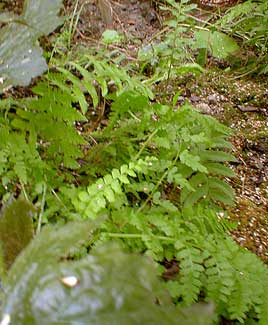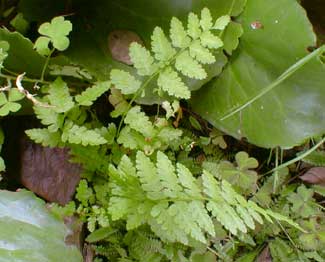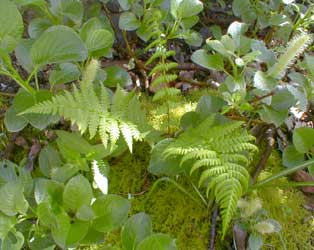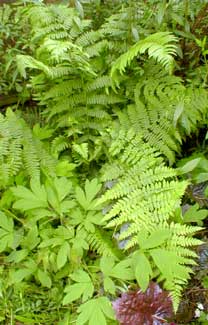
Northern Lady Fern
"They dug his grave but a bare foot deep,
By the edge of the Nine-Stone Burn,
And they covered him o'er with the heather-flower,
The moss & the Lady fern."
-Robert Surtees
1779-1834
1779-1834
Lady Ferns (Athyrium filix-femina) erupt in our garden unbidden, but perfectly welcome. They are one of the more common native ferns here on the Kitsap & Olympic penninsulas, found in moist shady areas from sea level up to 6,000 feet, above which heights they are replaced by the Alpine Lady Fern (A. distentifolium).
Although the Lady Fern is capable of reaching five feet of height in the wild, it is most commonly well under three feet. Those which have appeared in our gardens are usually only a foot tall at the outside.
One which I have observed by the bird-bath growing for three years running out of the center of a Yezo groundcover willow must have a considerable root system by now, yet has remained a veritable dwarf. But one of the several that have erupted here & there is noticeably larger every year, & as of mid-spring 2005 had gotten to a bit more than a two-foot spread.
 This deciduous fern self-selects surprisingly dark spots where flowers would languish, & where not even all that many weeds want to grow. The first photo (August 2003) shows one of a group of ferns that were for a couple years underneath a nandina. The nandina was in shade, & then further shaded the ferns. Eventually the nandina transplanted to a sunnier place, but the ferns that were under it remained deeply shaded by a cedar tree & a thimbleberry. That's the same ladyfern shown in the fourth photo below (May 2005) together with some foliage from a large white bleeding-heart.
This deciduous fern self-selects surprisingly dark spots where flowers would languish, & where not even all that many weeds want to grow. The first photo (August 2003) shows one of a group of ferns that were for a couple years underneath a nandina. The nandina was in shade, & then further shaded the ferns. Eventually the nandina transplanted to a sunnier place, but the ferns that were under it remained deeply shaded by a cedar tree & a thimbleberry. That's the same ladyfern shown in the fourth photo below (May 2005) together with some foliage from a large white bleeding-heart.The second photo (August 2003) shows a baby Lady Fern that suddenly appeared out from under the leaves of Bergenia crassifolia. Both of these are August 2003 portraits. The third photo (April 2004) yet another specimen that returns every year between some ground-hugging branches of the creeping Yezo willow.
Their behavior will vary greatly from zone to zone, even from one end of a garden to another. I make the effort to be sure water reaches them to keep them moist in dry weather, so that many of them are still strong looking until near the end of autumn. But examples in somewhat dryer places around the gardens will be dying back not later than mid-autumn, while any in places that experience oughtright droughtiness in summer have died back before summer's end yet still return the next spring. In less mellow climates than our own, without much more attention than our volunteer specimens require, they could well be dying back or at least awfully scruffy by high summer.
 They can survive just about anything so long as their lower roots are never entirely dry. It's typically among the first species to colonize after a clear-cut or a fire. Since the one thing it cannot do without is moisture, most spots they've appeared in our gardens has been rather close to drip hoses. Although the fragility of their stems means they can easily become damaged-looking, the more so toward the end of summer, they're so fond of spots so darkly shaded as ti be barely plantable anyway, they end up being wonderful fill-ins.
They can survive just about anything so long as their lower roots are never entirely dry. It's typically among the first species to colonize after a clear-cut or a fire. Since the one thing it cannot do without is moisture, most spots they've appeared in our gardens has been rather close to drip hoses. Although the fragility of their stems means they can easily become damaged-looking, the more so toward the end of summer, they're so fond of spots so darkly shaded as ti be barely plantable anyway, they end up being wonderful fill-ins. It is by no means only a coastal Northwest native, but has a circumpolar range throughout Europe & temperate Asia, besides the entirety of North America. The specific type here in the Northwest inclusive of Alaska & the wild & wooly west is D. f. var cyclosorum. Although some sources give cyclosorum the fuller status as a subspecies, I believe the current standing is as a variant. There are other subspecies or variants, besides endless numbers of cultivars (including the novel tatting fern). Regionally the appearance has considerable variety. For instance, though often described with upright fronds bending at the tips, those which grow around here are partially prostrate, especially when young.
The name "Lady Fern" is derived from the shape of the lacy fronds. These are narrow at the top & bottom, but wide at the center, like a large-hipped woman. This feature makes them easily identified.
 In the Victorian age there was a veritable fad for fern gardens in England, & the Lady Fern was one of the most popular of all. It seems to have fallen below the top-ten favorite ferns nowadays, as many other species of ferns remain tidy longer. But it has never entirely lost favor, thanks to its extreme hardiness in cold & temperate zones. There are in fact a vast number of Lady Fern cultivars in the trade, many of which put on a finer show than our spontaneously appearing wild ones.
In the Victorian age there was a veritable fad for fern gardens in England, & the Lady Fern was one of the most popular of all. It seems to have fallen below the top-ten favorite ferns nowadays, as many other species of ferns remain tidy longer. But it has never entirely lost favor, thanks to its extreme hardiness in cold & temperate zones. There are in fact a vast number of Lady Fern cultivars in the trade, many of which put on a finer show than our spontaneously appearing wild ones.They require no fertilization, indeed will do better without fertilizer, apart from nutrients that recharge the soil from natural leaf-fall & leafmold. Though its life is not at risk from storm or wind, the ease by which they become scruffy does rather demand that they be sheltered from harsh weather, merely to keep the stems from getting beaten up.
They are at their best April through August, but at first sign of frost, the fronds rapidly die back; there's nothing left of them by October's end. They return with spring rains, beginning with slow to moderate growth.
The first peoples of North America made a tea from the roots which had several medicinal uses, including for labor pains, or the powdered root was dusted onto small injuries to facilitate healing. The medicinal properties of the roots have been noted since Dioscorides in the first century C.E., having long been used to expel parasitic worms from humans & livestock. It is not so-used nowadays because of the risk of coma, blindness, or death.
The leaves are not nearly so toxic as the root. Although some believe it could prove to be toxic to livestock if browsed in sufficient quantity, rumors of livestock death seem to be impossible to validate. In our area, Lady Ferns are an autumn food choice for bears & for the Roosevelt Elk of the Olympic Penninsula, without after effects. Spring fiddleheads were eaten by Native Americans without injury. If one were worried about the potential toxicity, fiddleheads could be over-cooked to break down the filic acid.
Though care-free in the garden, after several years the root-crown may have built up to a stubby mound. If this is unappealing, the clump can be dug up & divided, & replanted so that the crown is once again flat with the ground. In a naturalistic woodland garden, however, a humpy old specimen might be sufficiently appealing to retain as-is.